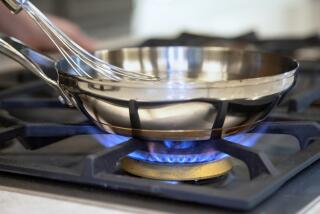Educating Others About Dangers of Deadly Gas
- Share via
Cheryl and Todd Burt know first-hand the deadly dangers of carbon monoxide poisoning. Two years ago, the Minnesota couple lost two sons after a faulty heater filled their home with the odorless gas.
The Burts, and their 7-year-old son, Ryan, survived. They came to Anaheim on Thursday to raise awareness about carbon monoxide poisoning and educate others in hopes of saving lives.
“Carbon monoxide is silent. It’s deadly,” said a teary Cheryl Burt, 35. “You don’t know it’s affecting you and once it gets to a certain point, you don’t care it’s affecting you. You’re powerless.”
The Burts were joined by the new Anaheim/Los Angeles Carbon Monoxide Task Force, a coalition of medical, fire and gas company officials, in promoting the safety message during a news conference Thursday at Martin Luther Hospital.
Since carbon monoxide slowly builds to a lethal level, one key to reducing deaths is installing carbon monoxide detectors, said Capt. Scott Brown of the Orange County Fire Authority. The detectors cost from about $25 to $50.
“All we know is it’s extremely important to have a device in your home that will prevent this,” said Cheryl Burt, holding photographs of her two sons who died. “It can happen to you.”
Carbon monoxide is the leading cause of poisoning deaths in the country, with more than 1,500 fatalities each year, Brown said. Carbon monoxide is odorless, colorless and tasteless, said Dr. James Pearle, Martin Luther’s medical director. Symptoms include headaches, vomiting, fatigue and confusion. A serious case can lead to seizure, coma and death.
The most effective treatment is the hyperbaric chamber, Pearle said. Patients at Martin Luther are placed in the capsule-like chamber and breath oxygen at high pressure to eliminate carbon monoxide from the body.
(BEGIN TEXT OF INFOBOX / INFOGRAPHIC)
Defeating a Silent Killer
Carbon monoxide poisoning often increases in winter because home heating equipment is used more often. Carbon monoxide is an odorless, invisible gas created when fuels--gasoline, wood, coal, propane, oil and methane--burn incompletely. Small amounts can build to harmful levels if a heating system is not working properly. Sources of carbon monoxide poisoning include:
* Gas heaters and furnaces
* Charcoal barbecues (used indoors)
* Gas ranges
* Kerosene heaters
* Wood stoves
Safety Tips
Do not allow vehicles or other fueled engines/motors to run inside a garage; carbon monoxide can seep inside a home, even if the garage door is open
Check fuel-burning household heating equipment--furnaces, water heaters, space heaters and wood stoves--each year; also inspect and clean vents and chimney flues
Open flue when using fireplace
Never use barbecues inside
Have qualified technician check heating and cooking systems before moving into a home
Appliances should be installed by a professional to ensure proper installation and adequate ventilation
Do not use kitchen gas ranges to heat rooms
Install carbon monoxide detector with UL rating which ensures it has been tested and proven to work.
For more information call (714) 744-0496
Sources: Orange County Fire Authority; Anaheim/Los Angeles Carbon Monoxide Task Force; Southern California Gas Co.; Researched by DEBRA CANO/For The Times
More to Read
Sign up for Essential California
The most important California stories and recommendations in your inbox every morning.
You may occasionally receive promotional content from the Los Angeles Times.









